Four young men sat on a platform before a pool, barechested and cross-legged. They raised their hands while holding a flower on the tip of their fingers, eyes closed and focused.
“First you raise your palms and put them together above your head, without any flower. That’s for Surya,” Bli Komang, our trusted driver, told me about the first part of a series of prayers before entering the pool of Pura Tirta Empul; Surya is the God of the Sun, one of the most venerated gods in Hinduism.
“Then you put a white flower on the tip of your fingers. That’s for Shiva,” he continued. “Next is red flower for Brahma. Then lastly you put red, white and yellow flowers for all gods.”
Balinese Hindus go to Pura Tirta Empul to seek ablution and blessing from the gods through the temple’s water spouts inside the main bathing pools. Built in the late 10th century, Tirta Empul – whose name translates into ‘water gush from the earth’ – consists of 30 water spouts, each has its own function and devotees come to shower under all or only certain spouts, depending on their needs.
Legend has it that the despotic King Mayadenawa of Bedahulu destroyed many temples on the island to prevent his people from praying to gods to seek protection. When the gods found out about this oppression they, led by Indra – the leader of the gods, came to earth to attack Mayadenawa.
Overwhelmed, Mayadenawa fled to a small village – an area now known as Tampaksiring – where he, with his magical power, created a poisonous spring. Unaware of Mayadenawa’s cunning action, many of Indra’s soldiers drank from the poisoned spring, and died – or severely ill according to other versions of the story. In response to this, Indra pierced the earth with his weapon and created a gush of water – Tirta Empul. He then revived his soldiers by sprinkling the water from the newly created spring onto them.
Today the spring water flows through 30 south-facing spouts, before streaming down onto Pakerisan River where another ancient Balinese site is located further downstream: Candi Gunung Kawi, a compound of temples and rock-hewn shrines built by one of the most powerful dynasties in Bali’s history.
The four young men were already inside the water, lining up before the first spout on the west end of the pool. “The way we do it is by showering under each spout, from left to right,” Bli Komang explained. Mind fixated to their own prayers, one by one they raised their hands, eyes closed, palms clasped, before showering under the refreshing water, blessed by the Kings of the Gods himself.
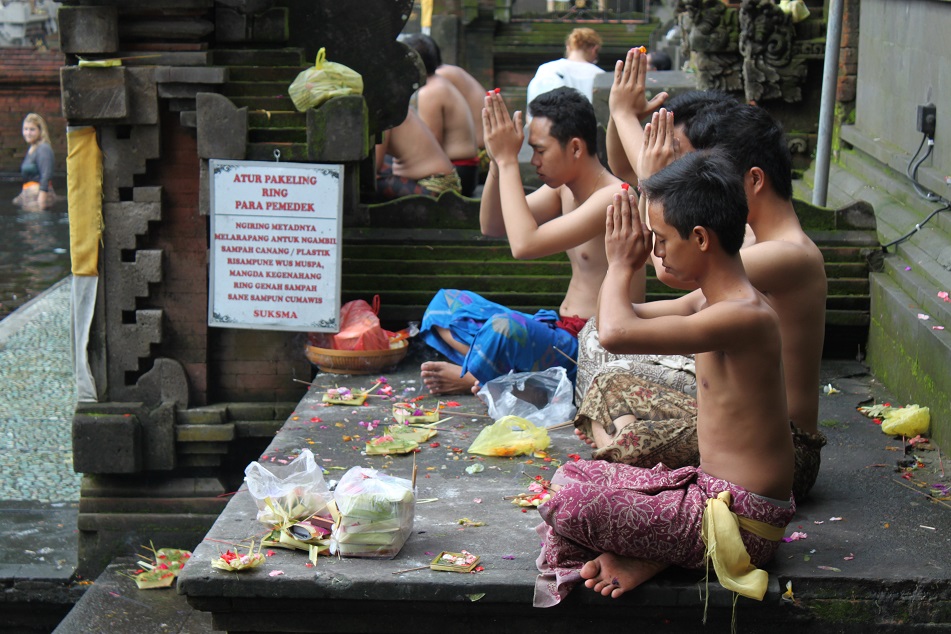
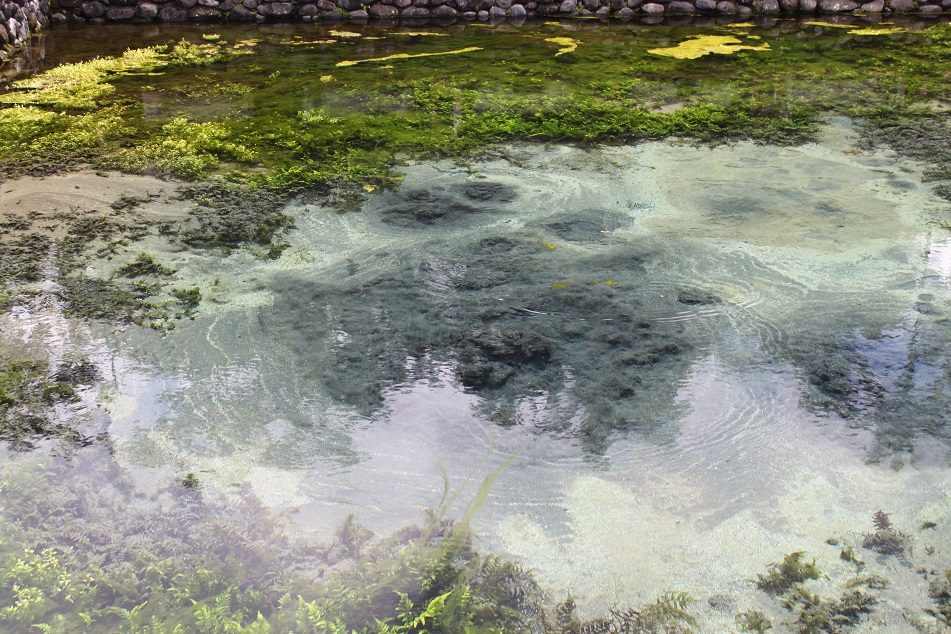
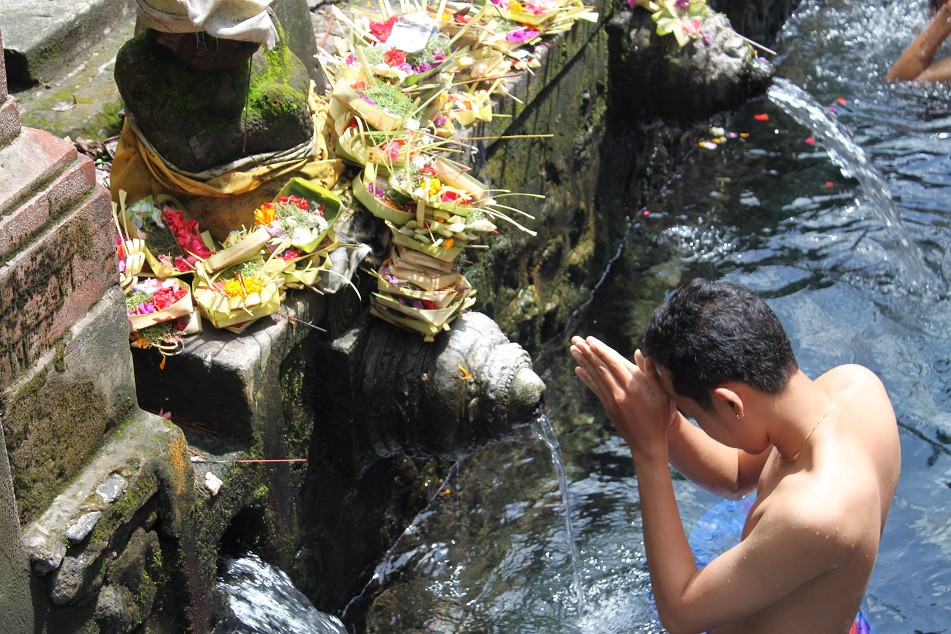
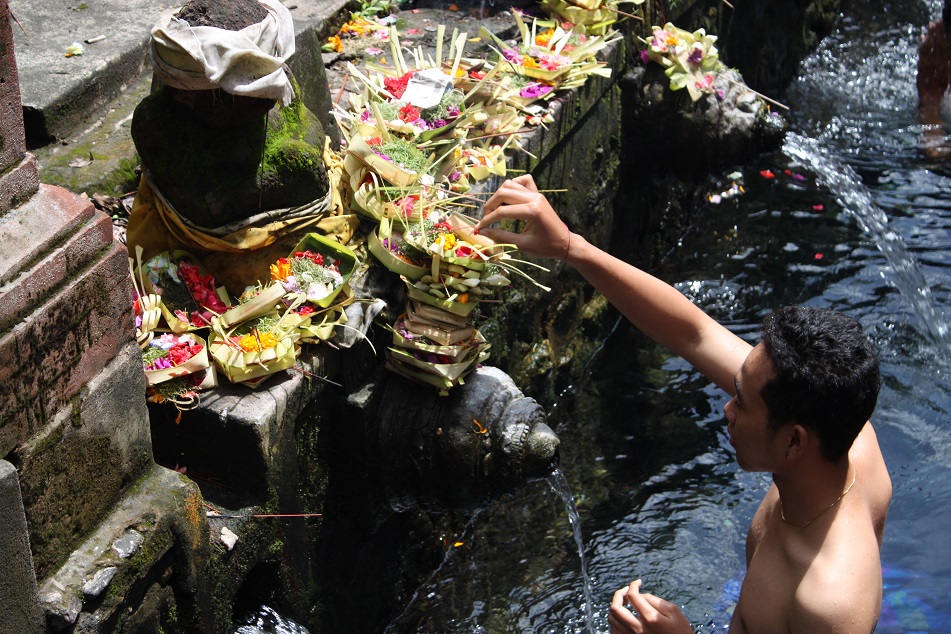
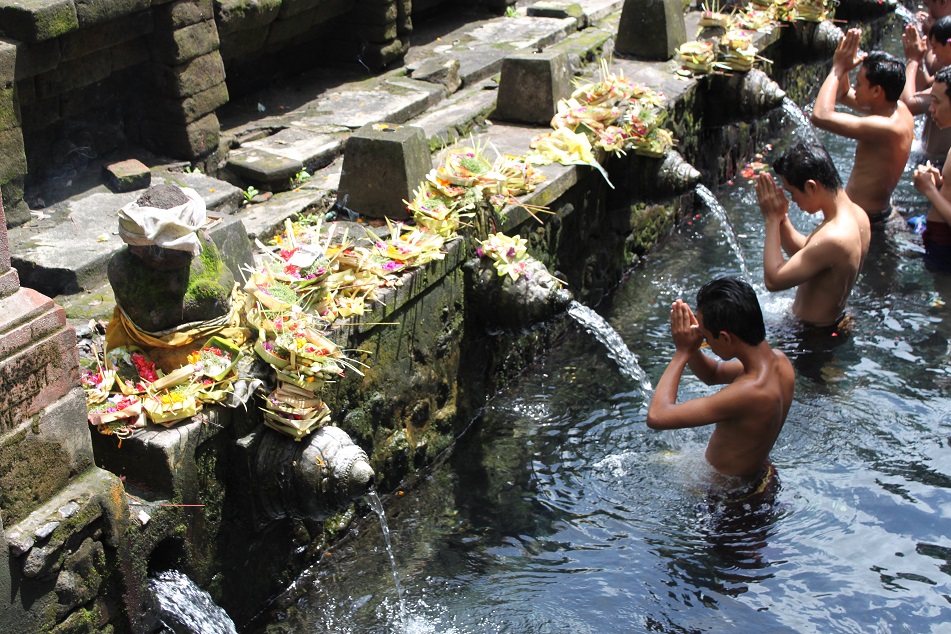
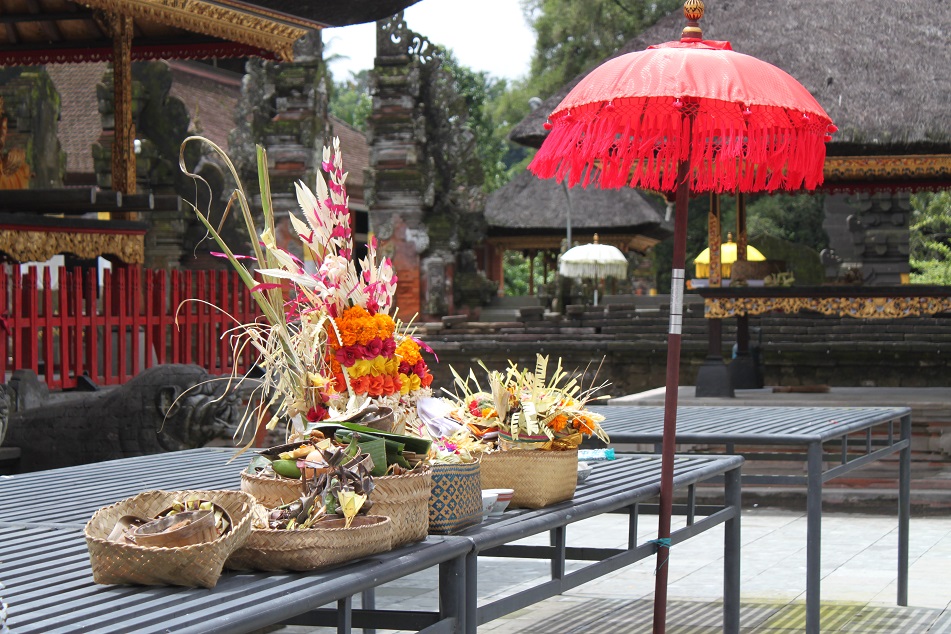


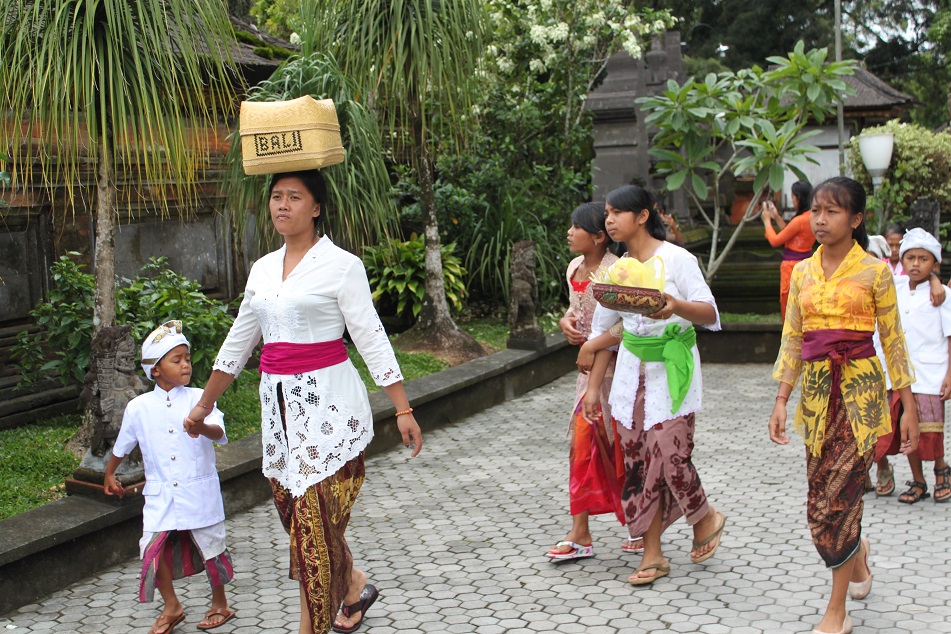
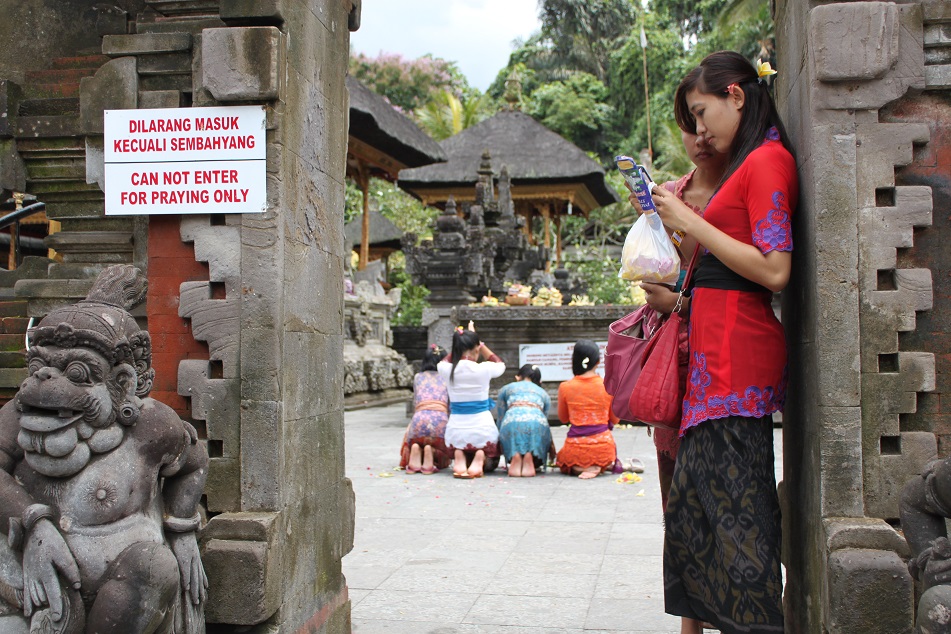

Reblogged this on lokyrastone.
LikeLike
Tirta Empul was such a gorgeous, photogenic place… my favourite part were the bathing pools stacked high with canang sari. I’m glad Bli Komang took us there on our first day with him. Lovely captures, Bama! 🙂
LikeLike
The first time I went in 2011 was anything like we experienced last December. It was a lot more crowded back then. I’m glad it was totally different when we went. The fact that UNESCO designated Pura Tirta Empul – alongside with other places that create Bali’s unique cultural landscape – a World Heritage Site makes this place even more special. Thanks James!
LikeLike
Dulu cuma sempet ke Candi Gunung Kawi, nggak nyangka Tirta Empul sama menariknya.
Like your story, Bama… And like the pic “Texting before entering the temple” 😀
LikeLike
Asal gak terlalu rame sih menarik banget Tirta Empul. Morning time is the best. Thanks Halim! Next time you come to Bali make sure you visit this temple. 🙂
LikeLike
I never got here, but your pictures are amazing. You sure loved your time in Ubud, what with Gunung Kawi as well. The Ubud area is an amazing part of Bali. http://backpackerlee.wordpress.com/2014/02/17/ubud-the-spiritual-heart-of-bali/
LikeLike
Thanks Lee! The next time you come to Bali make sure you visit Tirta Empul. Those who love taking a closer look at local cultures find this place very unique and beautiful.
LikeLike
Quite a fascinating tradition. Is this also practiced by women?
LikeLike
In fact women also practice the same tradition, Meredith. I just realized that I didn’t put any photo with women in it on this post. Back in the days when tourism hadn’t touched this part of Bali people showered without any clothes on, both men and women in the same pool – still a common practice today in less-touristed parts of the island.
LikeLike
I’m glad to hear that! Thanks.
LikeLike
A fascinating post Bama, especially with the back story and your atmospheric photos. The shot of the girl texting made me smile 🙂
LikeLike
Thank you, Madhu! I’m glad I went at the right time on my second visit to this temple as there were not many tourists. About that particular shot, at first I saw the sign at the gate, then I saw the girls, then I knew I had to take a picture of them. 🙂
LikeLike
well done, Bama.. always interesting.. I will go to Ubud early March. Thanks for inspiring
LikeLiked by 1 person
Thank you, Risty! Ubud in March sounds interesting as it is (supposed to be) the end of rainy season. Have fun there!
LikeLike
Hello Bama, very interesting post and as always it’s a treat to the eyes 🙂
LikeLike
Hi Sreejith,
Thank you so much! I’m going to write posts on Bali and Hong Kong in the upcoming weeks, so I hope you don’t get confused. 🙂
LikeLike
Waiting …. 🙂
LikeLike
Interesting as always 😀
LikeLike
Thanks a lot!
LikeLike
Nice read man!… easy to understand layout… interesting content, short and to the point… useful pictures that add depth to the story… well done fellow vagabond!!
LikeLike
Thanks, Nate! I’m glad you enjoyed this post. I really like your header photo. Very contemporary, clean and unique.
LikeLike
beautifully photographed at portrayed. I want to go see this place now. Thank you for sharing this incredible place.
LikeLike
Thank you, Shane! Bali is not that far from Perth, so book your flights now and go! 🙂
LikeLike
I was just reminiscing my trip to Bali last November and found your post. The one thing I love about Ubud was how much culture it had but also they were well connected. Tirta Empul had wifi and a boxing match showing in the pavilion!
LikeLike
I’m glad this post brings back some good memories to you. I do agree about Ubud and how different it is from other places in Bali, especially the more touristy southern part of the island. Ubud is where Balinese culture and art meet modern tourism industry. I didn’t know at all about that boxing match! Such a bizarre thing to have in a temple’s pavilion. 🙂
LikeLike
Rindu sekali…….I’ll be in Bali and Ubud later this year ….bulan septembre. Sangat beruntung memiliki iman saya pikir. Great images thanks Trees
LikeLike
Makasih Trees! September should be perfect for visiting Bali as rainy season hasn’t started yet. Selamat berlibur ke Bali!
LikeLike
dimana tuh
LikeLike
Pura Tirta Empul, Tampaksiring, Bali.
LikeLike
Yang boleh berbasuh di Tirta Empul cuma laki-laki ya, Bam? Jika ya, lalu bagaimana cara perempuan-perempuan ‘membilas’ jiwa & meminta berkah dari para dewa
LikeLike
Enggak Ka. Itu sebenernya laki-laki sama perempuan bareng. Cuma pas ambil foto kebetulan ada sekelompok anak muda itu, jadi secara gak disengaja lebih ngikutin prosesi mereka dari awal mereka sembahyang sampe masuk kolam.
LikeLike
eksotika bali, wujud kedamaian yang jadi potensi wisata
LikeLike
Betul sekali. Tapi tantangannya adalah bagaimana mengelola potensi wisata tersebut hingga bisa berkelanjutan, bukan sekedar eksploitasi yang hanya membawa keuntungan ekonomi jangka pendek.
LikeLike
Reblogged this on Giai01's Blog and commented:
xem
LikeLike
HI Bama, what a fascinating story. The first photo is deeply moving. I’m moved by the display of spiritual devotion of the people bathing in the spring. It reminded of the bathing ritual in Varanasi, India. I love the photo of the lady with the bananas in her head; it conveys so much about the simplicity of local life. And the photo of the texting lady made me smile. Somehow this kind of image has become universal.
LikeLike
Hi Marisol. Bali is one of those places where you can witness local people’s devotion to their religion and culture while at the same time embracing modernity, as depicted on that photo of a girl texting before entering a temple. I can imagine India shares so many things in common in regards to this. Thanks Marisol!
LikeLike
Reblogged this on Indytravels' Blog and commented:
we went here in 2012 and joined in the ceremony…such an inspiring place 🙂
LikeLike
Pingback: Revisiting Bali’s Spiritual Monuments | What an Amazing World!
Reblogged this on maverickbird.
LikeLike